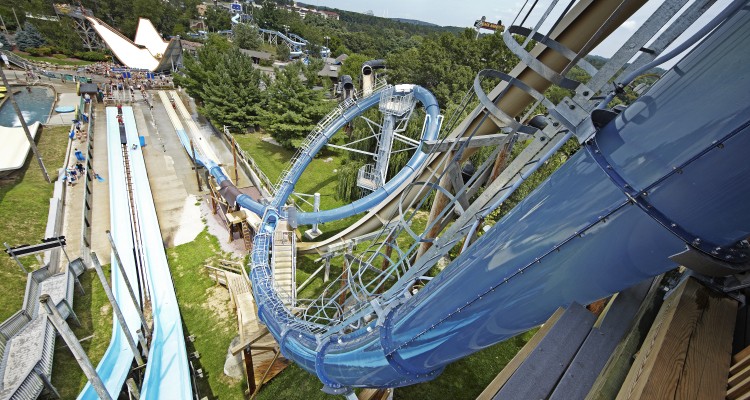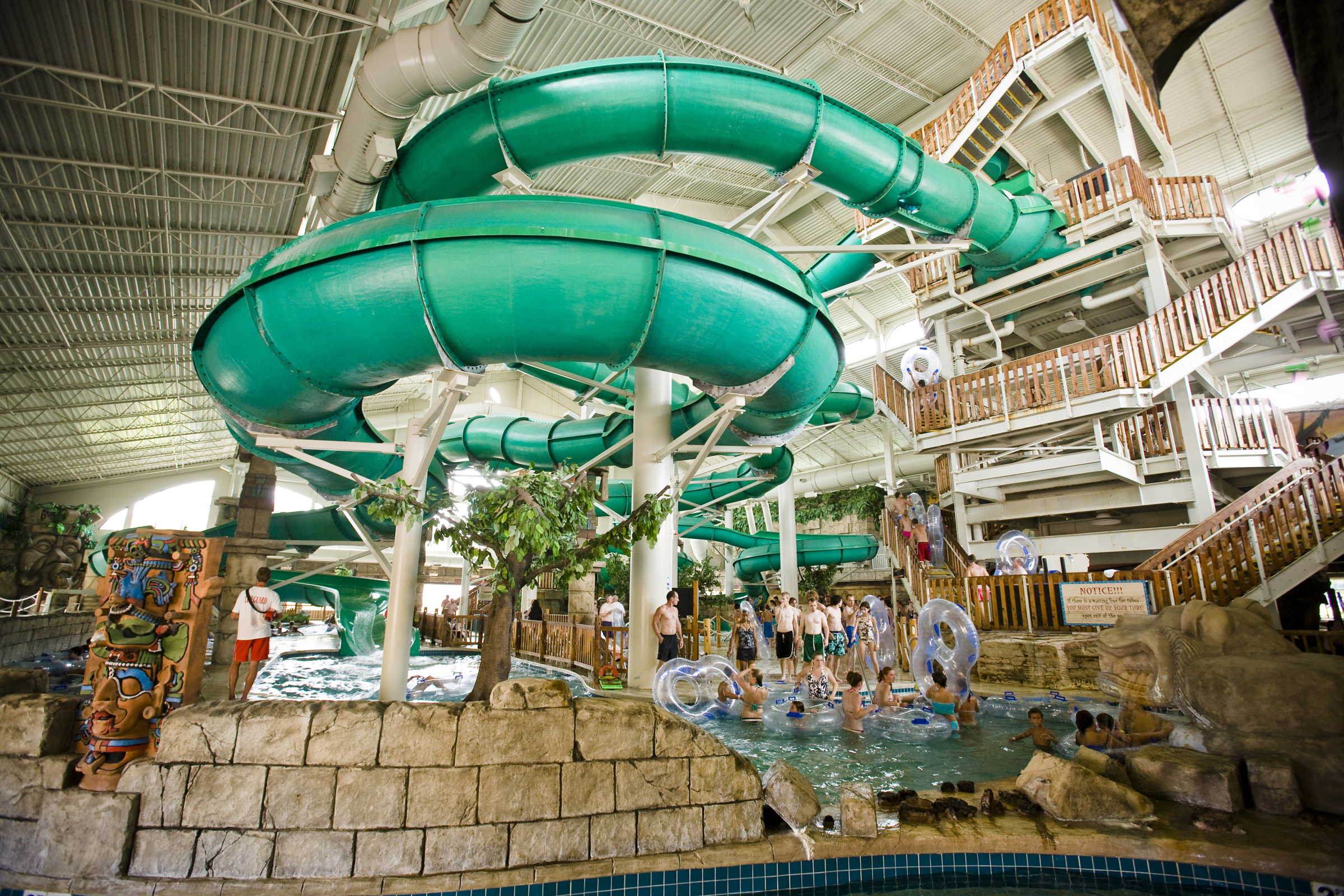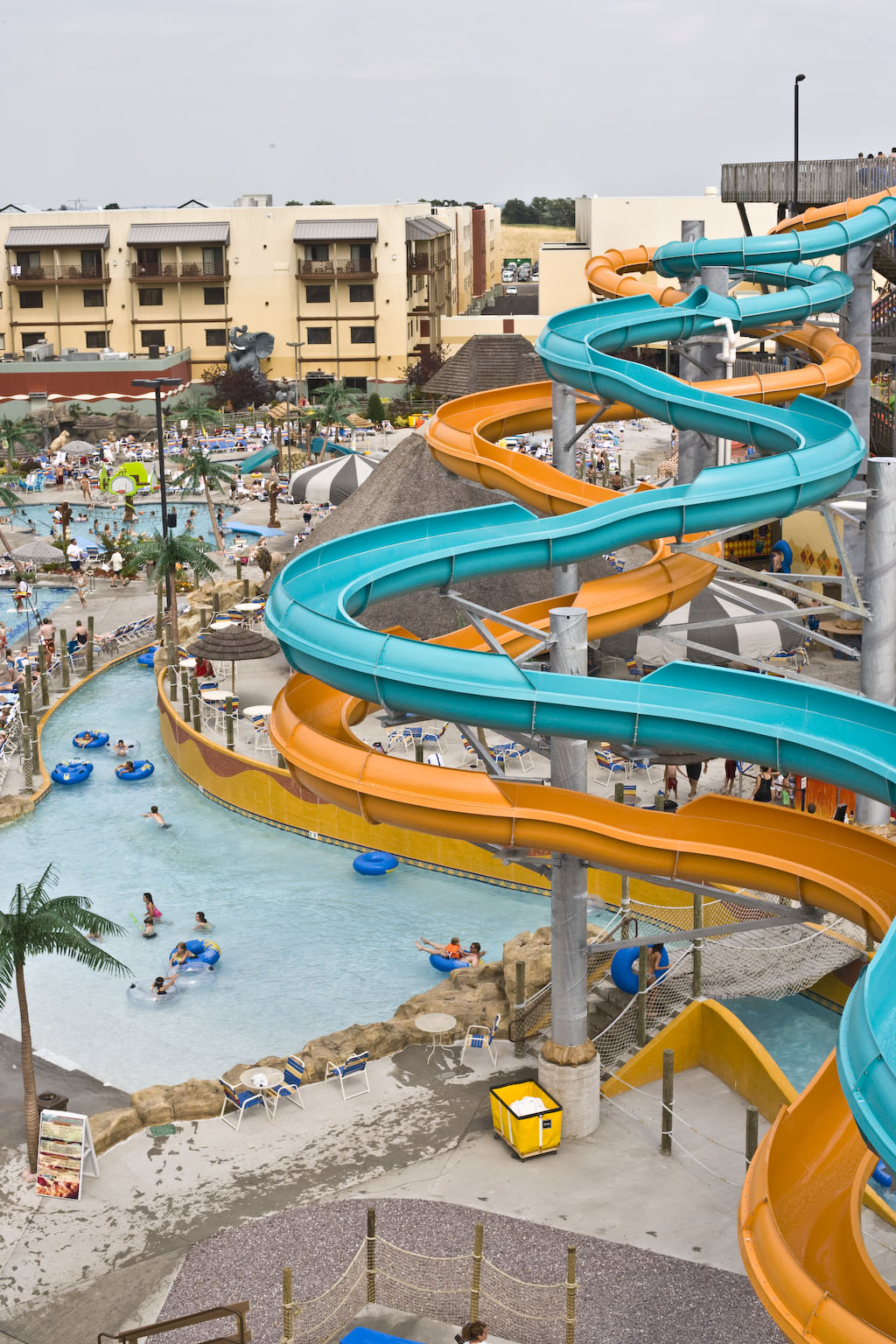
The Formation | The Draw | The Shift | The Future
The Shift
Now the lines go to a different place. They twist and turn—up 400 feet of stairs, 10 stories high, to the Scorpion’s Tail, a blue waterslide at Noah’s Ark Waterpark that brings the rider upside down. This line is one of hundreds that stretches up to the 200 waterslides in the Wisconsin Dells.
Drive through the Wisconsin Dells during any time of year, and you will see the pink and blue water slides arching toward the sky. Winding roller coasters, massive hotels, wax museums and souvenir shops complement the curvy tubes that millions of people splash down each summer. But waterslide season doesn’t end in August. Instead, most hotels in the Dells are equipped with their very own indoor waterparks and pools that hold millions of gallons of water.
Welcome to the “Waterpark Capital of the World.”
[youtube https://www.youtube.com/watch?v=IATXJDh3yYc&w=500&h=250]
In a little over two decades, the Dells has transformed from a place characterized by natural water to an area known mostly for a manufactured water experience.
The Wisconsin Dells Tourism website proudly states, “the Dells has more configurations of indoor and outdoor waterparks per capita than anywhere else on the planet.” The scale of the parks is staggering. The Dells is home to Noah’s Ark, complete with three miles of water slides and five million gallons of water, while the Wilderness Hotel and Golf Resort boasts 12 football field lengths of water park. The Kalahari Waterpark Resort holds the title of largest indoor waterpark in Wisconsin.
Clad with exotic names, vibrant water slides and fake palm trees make you feel as if you have left middle Wisconsin, waterparks have dominated the Dells and changed the dynamics of how money flows through the community.
Between 1995 and 2014, the number of rooms in the Dells area increased from roughly 3,000 to close to 10,000. The implementation of a room tax, in turn, allowed the Wisconsin Dells Visitor and Convention Bureau to increase the marketing budget put toward attracting visitors to the community.
“It’s that constant reinvestment, which is the whole purpose of room tax and what the room tax law mandates, that has allowed and really propelled this destination economically over the past 20 years,” says Romy Snyder from the Wisconsin Dells Visitor and Convention Bureau.
Just as the waterparks have boomed, so has the Dells’ marketing budget. According to Snyder, the marketing budget in 1995 was somewhere between $2 million to $3 million. Today it has quadrupled to $10.5 million.
Wave pools, uphill water rollercoaster slides and swim-up bars keep the tourists coming. But to operate these, as well as all of the waterparks, the Wisconsin Dells must use more than 16 million gallons of water at any given time.

Photo Credit: Wisconsin Dells Visitor and Convention Bureau
Go to Mt. Olympus Waterpark, even on a rainy early October day, and you will see hundreds of people splashing around in the park’s countless pools. While some may be riding down the Mayan-themed slides, others will be floating on rafts down the renowned lazy river. Fake rock formations, tiki heads and sunken ships cover every non-water expanse, giving you the feeling of taking a trip to a plastic Caribbean island.
Typically high amounts of water usage raise concerns about sustainability and water supply, but in the Dells, many believe the water supply is not an issue.
“In that particular area we don’t have many water quantity concerns, given that the Wisconsin River, the biggest river in the state, is right there,” says Bob Smail, a water supply specialist at the Wisconsin DNR.
“We have such an ample resource where water is concerned,” Smail says.
According to Smail, the water for the parks comes from the city, which gets water from the sandstone aquifer that comes from the Wisconsin River — which supplies more than enough water to accommodate the waterparks.
“The Wisconsin River flowing past the Dells averages 6,000 cubic feet per second, which equates to 4 billion gallons per day,” Smail says, while the village of Lake Delton’s average withdrawal for 2013 was around 550 million gallons.
After it’s been used in a water park, the water is then recycled, just as a normal swimming pool would do. The used water is treated and then pumped back out to the city to be used for things such as drinking water. Smail believes that it can be completely recycled.
Gerrad Bristol, the waterpark maintenance manager at Mt. Olympus Waterpark, acknowledges that a lot of water is being used, as one pool alone has 1.3 million gallons of water, but he, like Smail, has little concern about overuse of the water.
“All of the water that we do use is either evaporated and comes back or goes right back to the city,” Bristol says.
He says he would have no problem drinking water that has been recycled by the city from the waterpark.

Photo Credit: Wisconsin Dells Visitor and Convention Bureau
Elephants, trees, and bright yellows and oranges dominate the Kalahari Resort in the Dells. The entire expanse has the feel of an African jungle—a jungle complete with shops, a spa and a 125,000 square foot indoor waterpark, as well as an outdoor waterpark. The resort in itself is overwhelming, a massive set of buildings and endless parking lots.
Go inside and this feeling only grows, as kids scream, humidity suffocates, and adults and children alike ride the Flowrider, a ride that simulates boogie boarding on 50,000 gallons of water each minute.
Kim Koyle, manager of waterpark maintenance at the Kalahari Resort at the Dells, explains that while the pools are filled with a lot of water, contrary to common belief the park only uses about 100 gallons of water a day to top off the pools, and whole pools are rarely drained.
Kim Koyle, manager of waterpark maintenance at the Kalahari Resort at the Dells, explains the pump room and her day-to-day duties at the Kalahari Resort.
This minimizes water usage.
Smail also suggests that waterparks may actually be using the water more efficiently, as he, like most other residents, doesn’t recycle his water.
He says that while a large waterpark may use 50 million gallons of water a year, there are only 20 or so of them. Irrigation on average uses 20 to 25 millions gallons a year, but there are 4,000 irrigation wells in the state.
“[Waterparks’] water use is probably fairly small compared to other industries,” Smail says.
The belief of an almost-endless water supply and the fact that waterparks are recycling the water allows the parks in the Dells to operate with little concern about the environmental effects of high water usage.

Photo by Grey Satterfield
With the waterparks come towering hotels, shopping malls and more than four million giddy tourists annually, eager to see what the Dells has to offer. The tourists bring needs for flushing hotel toilets, warm showers to rinse off the chlorine from the pools and bottled water to quench their thirst after a long day in the sun.
The water consumption in the Dells did not end with the waterparks, but continues to grow as another hotel is built, as more tourists ride down slides filled with water from the once sacred Wisconsin River.
Although this water usage may not be a concern in the Dells, some community members worry about the kinds of effects water parks and development will have on the Dells as a sacred natural area.
“Waterparks are very good for the economy of the Dells, they certainly attract people, but I sometimes think they may pull people away from the natural aspects,” says Harlan Feldt, a Wisconsin Dells Boats tour guide. “There are people who come to the Dells and probably have no idea that this is all here.”
On the frontage road next to Culver’s stands the Alakai, a family-operated hotel that houses small indoor and outdoor water slides—nothing like the towering, swirling slides that intertwine outside the walls of the giant waterparks resorts nearby.
Alexandra Mucek, an employee at the Alakai Hotel, feels the Dells is a special place—but not because of its waterparks.
“We always highlight nature first,” she says. “Waterparks you can have anywhere in America.”
While tourism has certainly boosted the economy in the last decades, she questions if the magnitude of the indoor and outdoor waterpark options is really necessary.
“During the peak season you don’t need an indoor waterpark,” she says. “It’s a humongous space with a lot of overhead. Everyone wants to be outside in the summer.”
Debbie Kinder, a member of Stewards of the Dells, an organization dedicated to preserving and protecting the Wisconsin Dells river corridor, has tried to keep waterparks away from the natural areas of the Dells.
[soundcloud url=”https://api.soundcloud.com/tracks/177984812″ params=”color=ff5500&auto_play=false&hide_related=false&show_comments=true&show_user=true&show_reposts=false” width=”100%” height=”166″ iframe=”true” /]
Debbie Kinder, a member of Stewards of the Dells, discusses the expansion of Chula Vista waterpark and the development of the Grand Cambrian Resort.
While the DNR and Wisconsin Dells residents see little problem with the water usage of the parks, there is still concern over the switch to a commercialized water experience; the ever-growing thirst for water experiences in the Dells.
With each waterpark, the competition for something bigger and better grows, and the water consumption refuses to cease. We love water. But how far are we willing to push to harness this seemingly endless resource?

